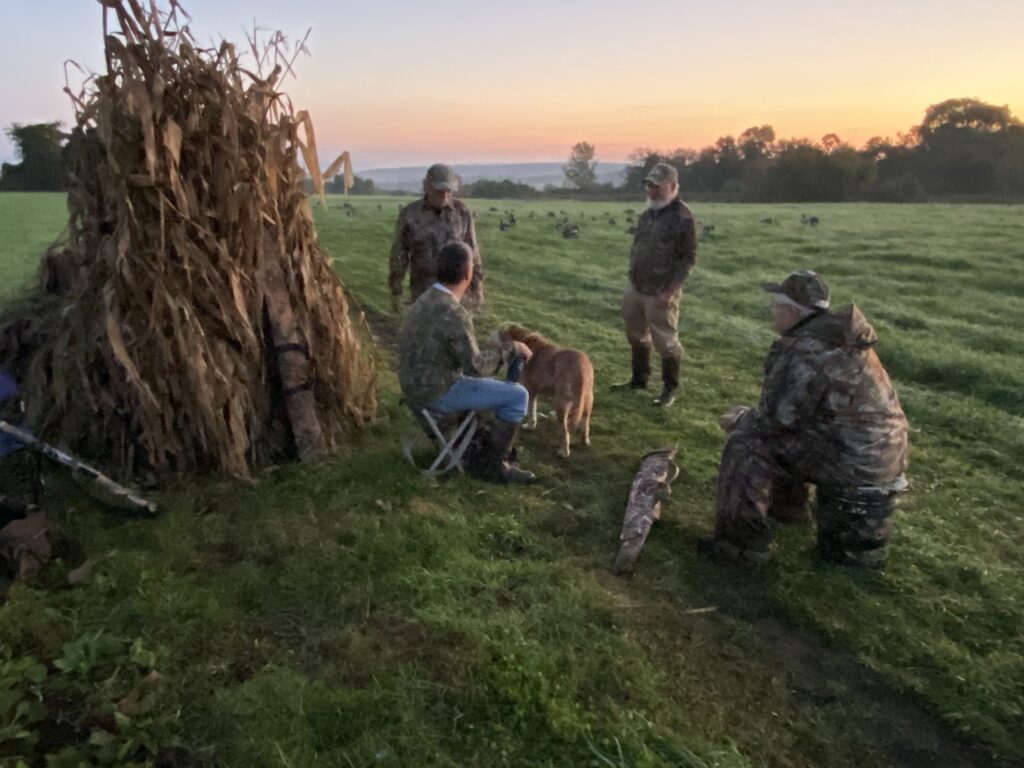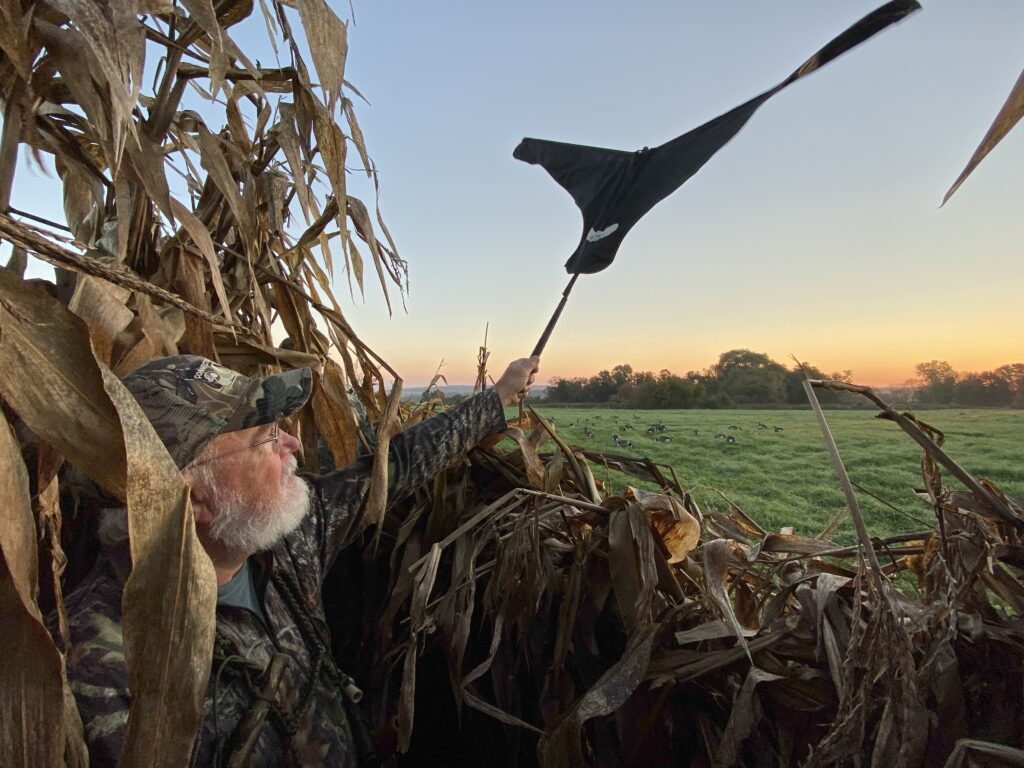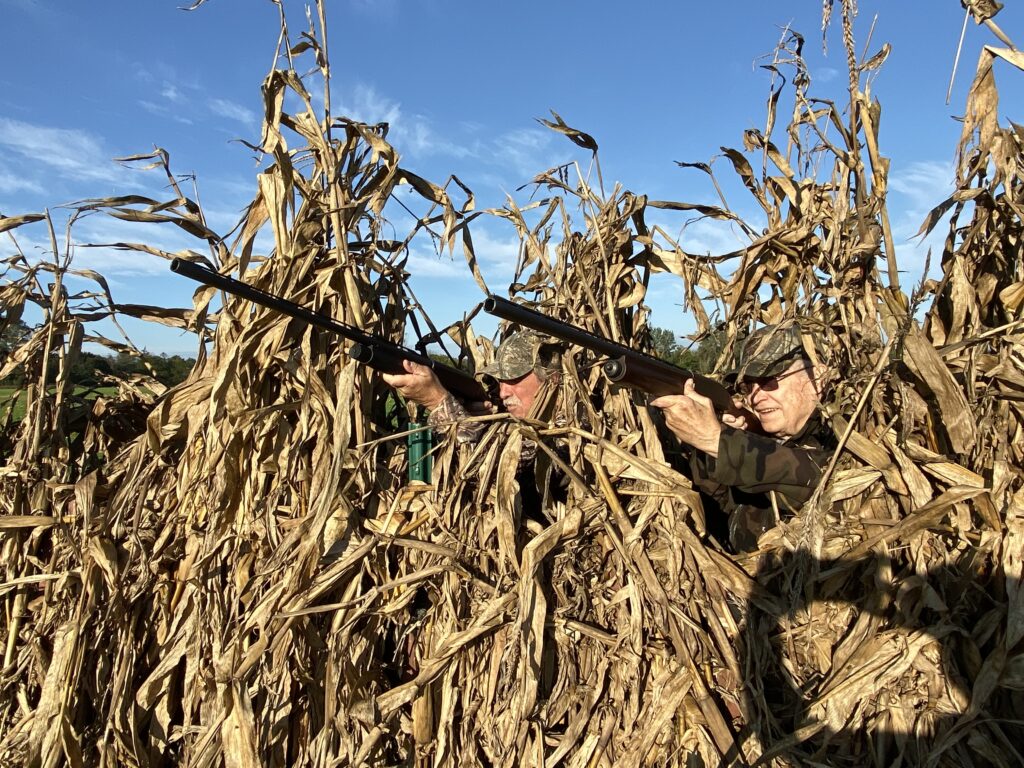NORTH FRANKLIN – The pre-dawn sky is just starting to brighten above the mowed hayfield where five camouflaged men go about their silent business.
Some guided by headlamps, they plant perhaps a hundred Canada Goose decoys in the soft ground, hoping they’ll be an irresistible lure for live members of the species to fill the skies above their cornstalk hunting blind.
By the time the first deep orange sun rays spread across the bright green cover crop of rye, the men have taken their stations in the blind, eyes to the sky and shotguns at the ready.
The array of decoys widely scattered in front of the blind is designed to mimic a flock of feeding geese, serving as a giant breakfast invitation to birds above.
“If you don’t have the decoys out they have no reason to come to this field,” and leave the adjacent cornfield where they have been feeding, explains Greg Chasko, a state waterfowl biologist for three decades and part of the group of retirees who mainly had careers in wildlife and waterfowl biology and management, as well as botany.

They’ve been through this drill countless times together, going back 30 years for some, and in far-flung places such as North Dakota and Saskatchewan.
On this morning, they’re hunting a field they’ve leased from a local farmer for several seasons.
Offering a 360-degree view, the field sits in the middle of seemingly-endless stretches of farmland, one of three such properties they’re renting this season in eastern Connecticut.
“We’re waiting for the geese to get up off their roost pond and fly into the field to feed,” Chasko says shortly after sunrise. “They usually start flying around 7-7:30,” a.m.
Sunny blue skies portending a balmy day are just taking over when the men notice a group of geese flying in the distance.
“Here they come – on both sides of the tree line,” says Steve, the tallest member of the bunch, wearing a camouflaged facemask and positioned at one outside edge of the blind. “There’s some down in the valley on the right and there’s some down in the valley on the left. But it looks like they’re staying in the valley.”
“Yeah, that’s a bad flight line,” offers Chasko, of East Haddam. “They’re not coming here. This field ain’t on their agenda today.”

Chasko is on the board of directors of the Connecticut Waterfowl Association, which offers a mentoring program he created to get newcomers, and especially younger people, involved in bird hunting.
The program is designed not only to pass on the tradition to new generations, he said, but to counter the steadily-declining number of people hunting overall.
“That’s the future. Hunters are the ones that pay for conservation,” he said, referencing license fees and taxes paid on guns and ammunition that are directed toward conservation efforts.
“As the number of hunters dwindles, the dollars for conservation dwindle.”
Each time one of the group spots another flock of birds, Chasko grabs a wooden goose-call hanging from his neck and blows a series of rapid, reedy, high-pitched honks.
“When you call you try to sound like a whole flock of geese, not just an individual one,” he explains.
Chasko also deploys what he calls The Flapper, a black-fabric outline of a goose attached to a rod that he waves out the front of the blind as birds approach.
“Might as well try everything we’ve got,” he says with a hint of frustration at the lack of geese flying within shooting range so far.
The geese they seek are a mix of “residents” that are here year-round, and migrants that just started arriving from northern areas such as Labrador and Newfoundland on their journey to overwinter here or as far south as North Carolina.
“They roost on a waterbody overnight – free from predators,” Chasko said. “And they get up in the morning and fly out and feed. By midday they’re back on the pond and then especially when it’s cold they feed in the afternoon before roosting for the night.”
So if the birds haven’t flown over their field by mid-morning, he said, chances are they’re not coming.
Whether or not it will be a successful day dominates the banter in the blind, which also consists of a substantial amount of good-natured teasing and what in sports is known as locker-room humor.

Each man has a nickname, which some inexplicably preferred to use as identification for this story.
“There’s Bonehead, Weeniehead, Truckstop and Chigger,” recites Chasko, a.k.a Captain Quack, prompting a chorus of wisecracks from his companions.
They all say they eat every bird they harvest. And with no real hunting action by 7:30 a.m. or so, botanist Bonehead breaks out a plastic container of his homemade corned duck breast, cut into hors d’oeuvres-sized slices for the group.
Not to be outdone, Captain Quack passes around his signature “goose sticks” – a rolled, spicy goose sausage.
The snack-time conversation, naturally, turns to hunting.
“I like hunting over decoys where the challenge is bringing these birds into close range so you can get a nice humane kill,” Chasko said. “Anyone can shoot a rifle accurately. But putting a string of shot out there and intercepting the bird in flight is a challenge. What’s the sport in shooting a literal sitting duck?”
Goose and duck hunting season started the previous weekend, and some of the group had already been out twice. A few days earlier, they quickly reached their daily bag limit of two when a flock of perhaps 700 birds drawn by their decoy imposters landed in a field they lease in Pomfret.
But today, their luck seems in short supply.
Hundreds of birds are spotted – over the nearby big willow, or the white house on a distant ridge, or near this or that tree line.
But sighting after sighting proves a false alarm, as each graceful line of geese angles out of shooting range.
“Something from the east would be nice – we just need them to come up the hedgerow,” Chasko says as 8 a.m. approaches.
“All these birds are just flying by like they’re migrating,” chimes in Chigger.
More bad news is the noticeable rise in temperature that has been creeping up all morning.
“It’s too warm too early,” Chasko bemoans. “The warmer it is, the less the geese need to eat to keep warm.”
Before long, the main conversation in the blind is when to pack up the decoys and go home, mixed with a few waning attempts at optimism when birds were spotted in the distance.

Connecticut has long had a problem with goose overpopulation and the spoilage they can bring, leading to the first-ever resident goose hunting season in the country in 1986.
But the omnipresent species that is so attracted to Connecticut’s landscape of lakes, ponds, fields and golf courses would not be reduced by a single member on this day, by this group.
By 8:30 a.m., the hunt is over, without a shot fired.
“It’s disappointing, but that’s just how it goes,” Chasko says as the men load their decoys and shotguns and other equipment back into their vehicles. “You get up in the middle of the night to get ready and then you don’t get to snap a cap. It happens.”
But the beautiful sunrise, the spotting of a kestrel and a peregrine falcon, and especially the camaraderie of the group, Chasko said, made it all worth it.
As he pulls his SUV out of the field, Chasko describes how hunting with his father as a young man in coastal Maryland taught him the transformative impact these excursions can have on those who pursue them, beyond enjoyment of the sport itself.
“My father and I had a very antagonistic relationship,” he recalls with a chuckle. “And the only time we got along was when we were hunting and fishing. Other than that it was out and out warfare.”
Information about the mentoring program may be found at http://www.ctwaterfowlers.org
Banner photo: Greg Chasko sets Canada Goose decoys in a hayfield (CT Examiner)

